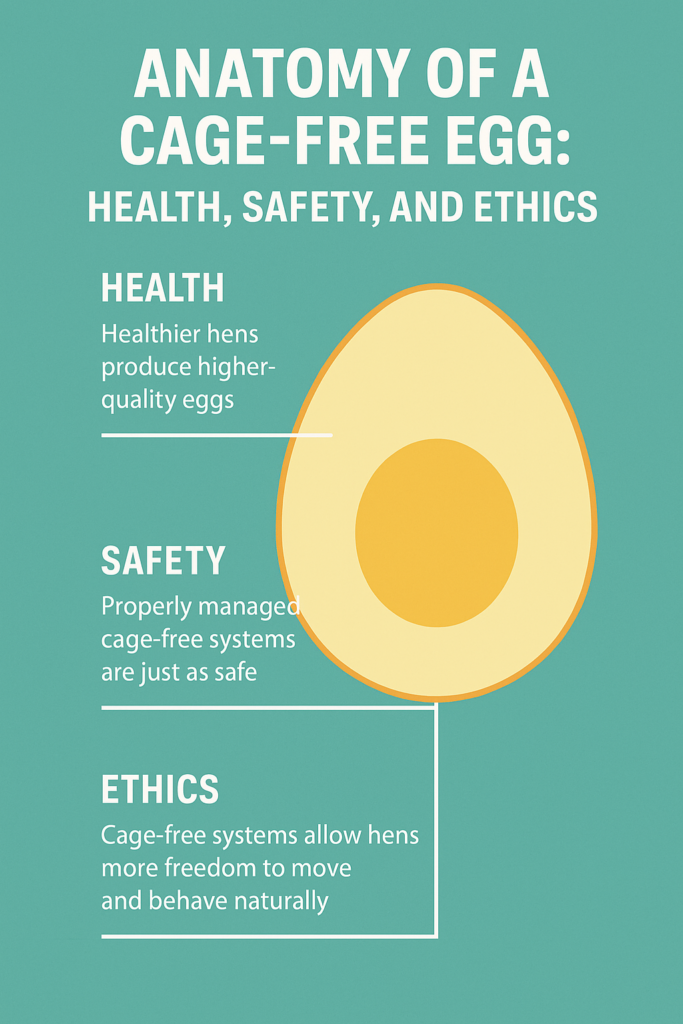When we talk about cage-free eggs, the focus is often on the welfare of the hens who lay them. But what about the eggs themselves? How different are they—really—from conventional caged eggs? And why does it matter?
In this post, we break down the health, safety, and ethical considerations that shape every cage-free egg. Whether you’re a conscious consumer, a business sourcing eggs, or simply someone who cares about food systems, here’s what you need to know.
✅ 1. Health: What’s in the Egg?
Studies comparing cage-free and caged eggs show nutritional differences can exist—though they may vary depending on the hen’s diet and environment. Some cage-free systems, especially those that allow for more natural foraging, tend to produce eggs that may contain:
- Higher vitamin D (thanks to natural sunlight exposure)
- More omega-3 fatty acids, if hens are fed enriched diets
- Better shell quality, due to improved overall hen health and mobility
While differences may be modest, they reflect a larger truth: healthier hens produce higher-quality eggs.
🛡️ 2. Safety: A Cleaner System, When Managed Well
One concern around cage-free eggs is cleanliness—after all, hens in open barns may lay eggs in different locations, potentially exposing them to contaminants. But here’s the catch:
📌 Properly managed cage-free systems are just as safe—and sometimes safer—than cage systems.
In fact:
- Crowded battery cages increase stress, weaken immunity, and can facilitate disease spread (like Salmonella).
- Caged systems make sanitation more difficult in large facilities.
- Cage-free farms that maintain high standards (e.g. nest box hygiene, regular egg collection, staff training) can match or exceed safety benchmarks.
Ultimately, biosecurity and management—not cages—are the most critical factors in egg safety.
🐔 3. Ethics: What Kind of System Are You Supporting?
This is where the cage-free egg truly stands apart.
Battery cages confine hens to a space smaller than an A4 sheet of paper, preventing them from walking, flapping their wings, or even turning around freely. These conditions cause:
- Severe physical health issues (bone weakness, feather loss)
- Chronic stress and psychological suffering
- Complete denial of natural behaviors
Cage-free systems still vary—but they offer hens more space, choice, and movement:
- Ability to lay eggs in nests
- Freedom to walk, perch, scratch, and dust-bathe
- Greater opportunities for social interaction and exploration
While cage-free isn’t perfect, it represents a major step forward in reducing suffering and respecting animals as sentient beings.
🧭 The Bigger Picture: Your Egg, Your Impact
Every egg you buy sends a signal—to farmers, to corporations, and to the food system as a whole.
Choosing cage-free eggs means:
- Supporting better animal welfare
- Backing farms that invest in safer, cleaner systems
- Encouraging food companies to stick to their public commitments
And beyond the carton, your decision contributes to a larger shift—away from hidden cruelty, and toward transparency, ethics, and compassion.
Final Thoughts
A cage-free egg is more than a label. It’s a reflection of how we treat the animals in our food system—and what kind of future we want to create.
Better health. Safer systems. A more humane standard. That’s the anatomy of a cage-free egg.

